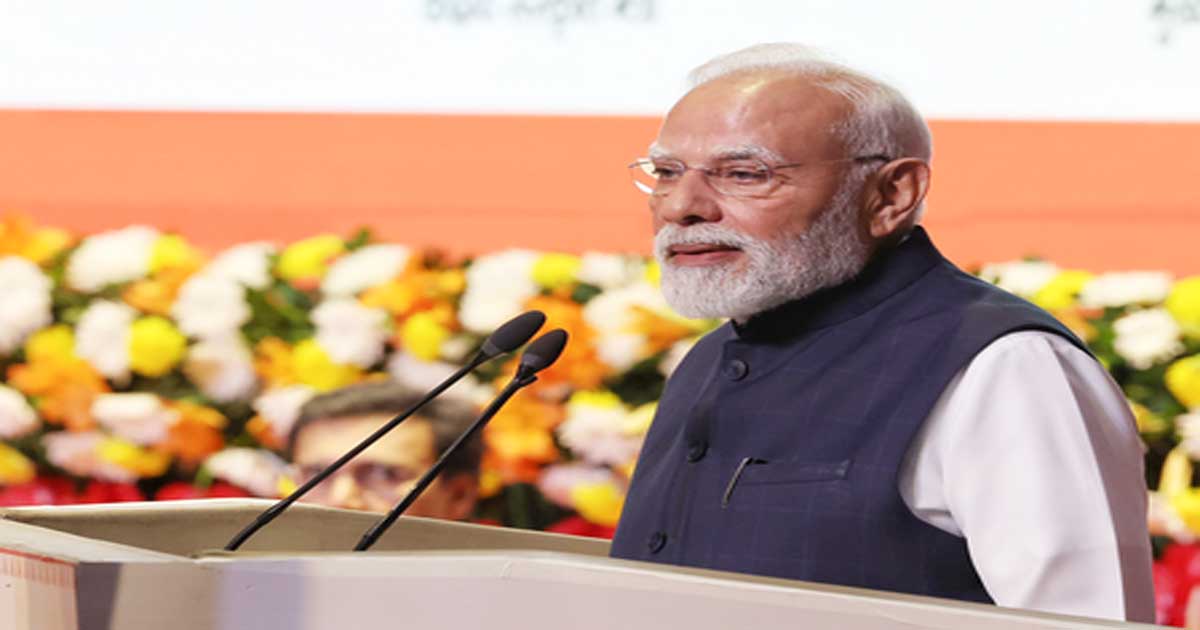Business
FY22 tax collection exceeds budgetary estimate, rises to over Rs 27 lakh cr

Accelerated economic recovery along with enhanced compliance pushed India’s FY22 tax collection to Rs 27.07 lakh crore, almost Rs 5 lakh crore above the Union budget’s estimate of Rs 22.17 lakh crore.
Accordingly, the current tax collection grew by 34 per cent over last year’s revenue collection of Rs 20.27 lakh crore, led by a growth of 49 per cent in direct taxes and supported by a 20 per cent growth in indirect taxes.
“This revenue growth has been propelled by rapid economic recovery after successive waves of Covid, supported by one of the largest immunisation programme of the world run by the government,” the Ministry of Finance said.
“It also signifies a robust recovery in the economy. This was also supplemented with better compliance efforts in taxation. Various efforts were taken by tax administration on direct as well indirect taxes to nudge higher compliance through use of technology and artificial intelligence.”
Besides, FY22 marked the highest tax-GDP ratio of 11.7 per cent, with direct tax to GDP ratio at 6.1 per cent and indirect tax to GDP ratio at 5.6 per cent.
“The tax buoyancy (which is a measure of growth in tax revenues as compared to GDP growth) is at a very healthy figure of 1.9, with 2.8 for direct taxes and 1.1 for indirect taxes. The ratio of direct to indirect taxes recovered from 0.9 in 2020-21 back to 1.1 in 2021-22.”
As per the ministry, the gross corporate taxes during 2021-22 was Rs 8.6 lakh crore against Rs 6.5 lakh crore last year, which shows that the new simplified tax regime with low rates and no exemptions has lived up to its promise. Furthermore, the ministry said that during the year, the income tax department gave refunds of Rs 2.24 lakh core.
“During last two years, the effort has been to clear backlog of refunds to infuse liquidity into the hands of businesses.”
“During the year, 2.4 crore refunds were issued that included 2.01 crore related to the year 2021-22, for which the returns were filed till 31st March 2021.”
Additionally, this has been possible due to faster processing of returns.
“During 2021-22, 22.4 per cent returns were processed on the same day and around 75 per cent returns were processed in less than a month time. The average processing time for returns during 2021-22 was 26 days. During the year, 7.14 crore returns were filed as compared to 6.97 crore last year.”
According to the ministry, on the indirect tax front, GST saw “an exemplary growth during 2021-22 despite two waves of Covid-19 pandemic”.
“CGST revenues increased from Rs 4.6 lakh crore last year to Rs 5.9 lakh crore in 2021-22. The average monthly gross GST revenue in 2021-22 was Rs 1.23 lakh crore as compared to Rs 94,734 in 2020-21 and Rs 1.01 lakh crore in 2019-20.”
“This again signifies a robust rebound in the economy. This has been complemented due to various measures taken to improve compliance. This shows that the GST ecosystem has appreciated the invoice-based discipline in GST, which not only benefits GST revenues but also contributes to overall formalization in the economy.”
Additionally, the ministry said that the level of economic recovery can also be seen from the value of e-way bills generated every month, which has improved from Rs 16.9 lakh crore in January 2021 to Rs 25.7 lakh crore in March 2022.
In addition, during 2021-22, Customs duty has witnessed a growth rate of 48 per cent.
“During the last two years, the government has undertaken comprehensive review and rationalisation of the Customs tariff structure through extensive consultations and crowd sourcing and has rationalised various exemptions and simplified the tariff structure.”
“It is expected that the trend of recovery in the economy and tax revenues of the government will continue to grow.”
Business
Sensex, Nifty extend gains on buying in heavyweights

Mumbai, Oct 7: Indian stock markets continued their upward trend on Tuesday, supported by buying in major stocks such as ICICI Bank, ITC and more.
However, profit booking in select banking stocks limited the overall gains during the early trading hours.
The Sensex, which rose more than 100 points in early trade, was trading at 81,843, up 52 points or 0.06 per cent.
The Nifty also gained 34 points or 0.14 per cent to reach 25,112 after hitting an intra-day high of 25,140.
Among the top gainers on the Sensex were Power Grid, Bajaj Finance, HCL Tech, Bharti Airtel, ICICI Bank, Ultratech Cement, NTPC, Hindustan Unilever, Bajaj Finserv, and BEL, which rose between 0.3 per cent and 1.6 per cent.
On the other hand, Trent, Axis Bank, Tata Motors, TCS, SBI, Kotak Bank, Tech Mahindra, HDFC Bank, and Infosys were among the major losers, slipping up to 2.7 per cent.
In the broader market, the Nifty MidCap index gained 0.08 per cent, while the Nifty SmallCap index rose 0.41 per cent — showing continued interest from investors in smaller companies.
Among sectoral indices, Nifty Metal and Nifty IT were the top performers, each gaining 0.4 per cent.
The Nifty PSU Bank index was the worst hit, falling 0.3 per cent due to profit booking in public sector lenders.
Analysts said that overall market sentiment remains positive, though some volatility may persist due to profit-taking at higher levels.
“The ongoing mild rally in the market has the potential to gain momentum. The FII selling in India is slowly declining since the sharp appreciation in other markets has pushed up their valuations and the valuation differential between India and other markets has come down,” analysts said.
“Since there is huge short position in the market any positive news can trigger short-covering, further aiding the rally,” they added.
Business
PM Modi to inaugurate India Mobile Congress 2025 on October 8

New Delhi, Oct 6: Prime Minister Narendra Modi will inaugurate the India Mobile Congress (IMC) 2025, Asia’s premier telecom and technology event, on October 8 in the national capital, Ministry of Communications said on Monday.
The four-day mega event, themed “Innovate to Transform,” will run till October 11 and is expected to showcase India’s growing leadership in the global digital and telecom space.
Union Minister for Communications Jyotiraditya M. Scindia visited the IMC 2025 venue to review the final preparations ahead of the Prime Minister’s inauguration.
Scindia also travelled to the venue and back via the Airport Metro, symbolising India’s push for modern and sustainable urban transport.
During his visit, the minister toured the exhibition area, interacted with participating startups and exhibitors, and chaired review meetings with senior officials from the Department of Telecommunications (DoT), the Cellular Operators Association of India (COAI), and other partner agencies.
Speaking to the media, Scindia said that IMC 2025 would mark a new era in global connectivity, where technologies like 5G, 6G, artificial intelligence (AI), machine learning (ML), the Internet of Things (IoT), and satellite communications would come together to shape the future.
He emphasised that the event reflects Prime Minister Modi’s vision of a self-reliant and innovative India that connects not only within but also with the world.
IMC 2025 is expected to attract more than 1.5 lakh visitors, 7,000 delegates from over 150 countries, and 400 exhibitors spread across 4.5 lakh square feet.
The event will also feature over 1,600 technology demonstrations and 100 sessions with more than 800 speakers discussing the latest developments in telecom and digital innovation.
Highlighting the scale of the event, Scindia said that IMC has grown from being a national platform to becoming a global technology congress that represents India’s digital leadership.
He added that the 2025 edition will include six major global summits — covering 6G research, artificial intelligence, cybersecurity, satellite communications, startups, and the Global Startup World Cup — India Edition.
The minister also underlined India’s achievements in the telecom sector, noting that the country now ranks among the world’s top three digital economies with 1.2 billion mobile subscribers, 970 million internet users, and the fastest-ever 5G rollout completed in just 22 months.
Business
Sensex rises 583 points, Nifty tops 25,000 as IT and banking stocks lead rally

Mumbai, Oct 6: The Indian stock markets continued their winning streak for the third straight session on Monday, driven by strong buying in the IT and banking shares.
The benchmark Sensex jumped 582.95 points, or 0.72 per cent, to close at 81,790.12, while the Nifty rose 183.4 points, or 0.74 per cent, to end the day at 25,077.
“From a technical perspective, Nifty has successfully broken above the key psychological and technical resistance level of 25,000, turning the structure decisively positive,” analysts said.
“Any dip toward the 25,000 zone is expected to act as a strong support level, with immediate resistance seen at 25,200 and 25,500,” they added.
The Bank Nifty also delivered a stellar performance, opening with a gap-up and maintaining its upward trajectory through the session.
The index surged past 56,100, hitting an intra-day high of 56,164, with next resistance levels seen at 56,300–56,500, and support placed around 55,821–55,500, experts stated.
Broader markets also joined the rally, with the Nifty Midcap 100 gaining 0.89 per cent and the Nifty Smallcap 100 inching up 0.28 per cent.
In the Sensex pack, TCS, Tech Mahindra, Eternal, Axis Bank, and Bajaj Finance were the top performers, climbing as much as 3 per cent.
Meanwhile, Trent, Tata Steel, Power Grid, and Titan ended the session with losses. Among sectors, IT stocks led the gains as the Nifty IT index surged 2.28 per cent.
The Nifty Private Bank, Financial Services, and Healthcare indices also closed in positive territory.
On the other hand, Metal, FMCG, and Media shares came under pressure, slipping up to 1 per cent.
Market experts said the upbeat sentiment in IT stocks and strong institutional buying supported the overall market momentum.
“The domestic equity market ended the session on a positive note, led by gains in the financial services and IT sectors, ahead of the Q2 results,” they said.
“The banking index outperformed, bolstered by strong quarterly updates announced by large scheduled banks and attractive valuations, while hospital stocks surged following the revision of CGHS rates,” market experts added.
-

 Crime3 years ago
Crime3 years agoClass 10 student jumps to death in Jaipur
-

 Maharashtra1 year ago
Maharashtra1 year agoMumbai Local Train Update: Central Railway’s New Timetable Comes Into Effect; Check Full List Of Revised Timings & Stations
-

 Maharashtra12 months ago
Maharashtra12 months agoMumbai To Go Toll-Free Tonight! Maharashtra Govt Announces Complete Toll Waiver For Light Motor Vehicles At All 5 Entry Points Of City
-

 Maharashtra1 year ago
Maharashtra1 year agoFalse photo of Imtiaz Jaleel’s rally, exposing the fooling conspiracy
-

 National News12 months ago
National News12 months agoMinistry of Railways rolls out Special Drive 4.0 with focus on digitisation, cleanliness, inclusiveness and grievance redressal
-

 Maharashtra11 months ago
Maharashtra11 months agoMaharashtra Elections 2024: Mumbai Metro & BEST Services Extended Till Midnight On Voting Day
-

 National News1 year ago
National News1 year agoJ&K: 4 Jawans Killed, 28 Injured After Bus Carrying BSF Personnel For Poll Duty Falls Into Gorge In Budgam; Terrifying Visuals Surface
-

 Crime12 months ago
Crime12 months agoBaba Siddique Murder: Mumbai Police Unable To Get Lawrence Bishnoi Custody Due To Home Ministry Order, Says Report












